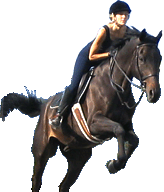|
Saddle seat riding began in the United States, when smooth-moving,
high-stepping horses were used by plantation owners to travel across
their fields. All saddle seat riding is done on the flat never over
fences.
Saddle seat riders use a special saddle not seen in other riding
disciplines. The pommel and cantle have been raised, providing a
deeper more supportive saddle seat. The saddle-shaped seat naturally
puts the pelvis into the right position to preserve the natural
curve of the spine. Most saddle seat saddles attempt to position
the rider's body, at or near the 15th vertebrae of the horse.
The saddle cannot interfere with the rider's use of leg and seat.
The extra deep seat ensures a secure feeling in the saddle. The
deepest part of the saddle's seat is tipped back toward the cantle.
A deep-seated saddle should sit higher in the back because of a
bigger cantle which is not designed to be sat on. The pommel and
cantle have been raised, providing a deeper more supportive saddle
seat. A jumping saddle will have a shorter and more forward flap
than a dressage saddle, with the seat slightly more towards the
cantle.
A saddle seat horse should be thrilling to watch; extremely elegant,
classy, and stylish. Many horses used in saddle seat are shod with
pads and special shoes, so they pick their feet up higher. In the
saddle seat show ring no formal attire can be worn in pleasure or
pleasure equitation classes and spurs are generally not worn by
saddle seat riders.
About the Author
Rob Daniels has been an equestrian
rider for 25 years. He has studied various disciplines additional
articles are available at: Riding Stable - http://www.riding-stable.com
and Horse Stall http://www.horse-stall.net
|


